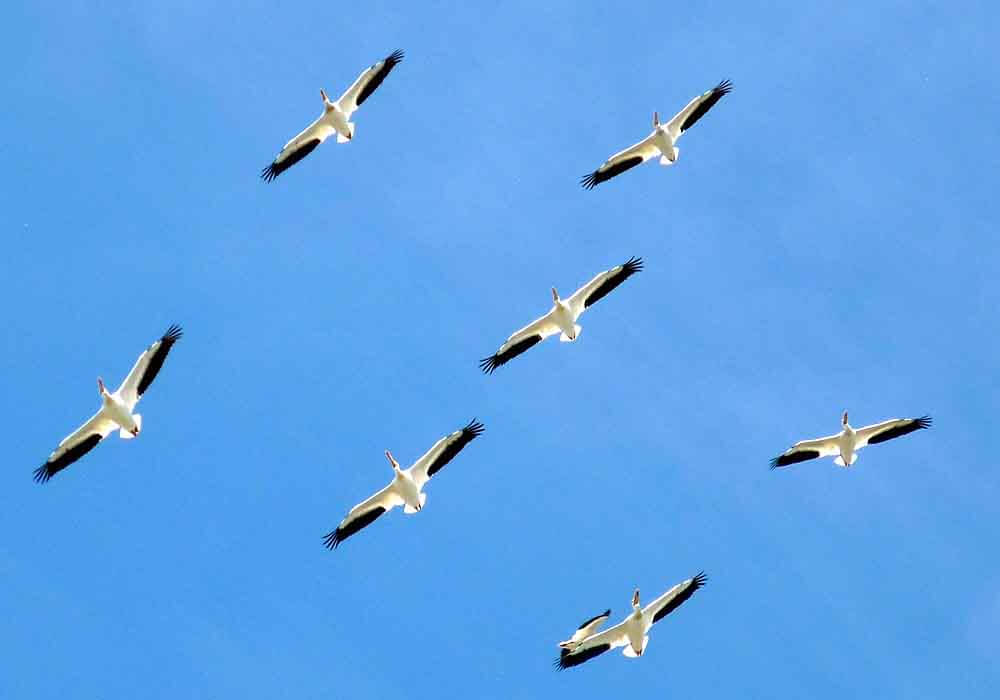Why Do Birds Fly?
Understanding The Beauty Of Bird Flight
Understanding why birds fly involves a blend of scientific
examination and appreciating natural splendor. Constantly intriguing observers
and scientists alike, bird flight summons profound awe and fascination. Bird
behavior in flight often stirs curiosity, leading us to ask: Why do birds fly?
Why do they fly in a V-shape? Or even, why do they fly in circles?
Birds fly for diverse reasons such as searching for food,
escaping from predators, migrating to more favorable conditions, and at times,
simply for the joy of soaring through the sky. But the act of flight isn't as
easy as it might initially seem. Birds' anatomy, specifically their lightweight
bodies, streamlined shape, and powerful flight muscles, all contribute to their
ability to take to the skies.

Understanding Bird
Flight Patterns…
Why Do Birds Fly In A V Shape?
One of the most captivating sights in nature is the image of a flock of birds flying together in a wide, V-shaped formation often eliciting amazement at avian navigation skills. Their strategic alignment isn't just visually pleasing; it has a vital purpose.
The V-shaped formation that birds often adopt during flight, called an echelon formation, reduces the exertion required by each individual bird. It's an instance of teamwork in the animal kingdom, with each bird, except the leader, flying in the upwash from the wing of the bird ahead.
This upwash is an area of disturbed air created by the
leading bird's wings, which provides additional lift for the birds behind it,
thus reducing their energy expenditure. The leader, usually the strongest bird,
does not enjoy this advantage and therefore periodically rotates to the rear of
the formation, passing the leadership role to another bird.
Why Do Birds Fly South For The Winter?
As temperatures drop and food becomes scarce in winter, birds migrate to warmer climes, often towards the equator. This shift in location provides them with greater access to food resources and a more hospitable environment.
The phenomenal feat of avian navigation during this journey,
navigating over thousands of miles, continues to captivate observers. Some
theories suggest they use the earth's magnetic field as a compass, observe
celestial bodies, or rely on their sense of smell or memorized landmarks.
Why Do Birds Fly In Circles?
Birds fly in circles for several reasons. Predatory birds or raptors often circle as they search for prey, using thermals (rising pockets of warm air) to gain altitude without expending much energy.
Thermals provide a lift that birds use to their advantage. By circling within these columns of warm air, birds can sustain their altitude and extend their flights. This behavior also helps birds scan larger areas for food while efficiently maintaining height.
Birds also fly in circles during courtship rituals and
territorial disputes, employing the skill to both impress potential mates and
intimidate rivals.
Why Do Birds Fly Together?

Birds fly together for protection, efficiency, and companionship. Within a flock, birds can watch out for predators and share information about food sources. They can also draft off one another, like cyclists in a peloton, to reduce the energy they need to fly.
Biologists believe that birds can learn new information during these interactions, such as more efficient migratory routes or new food sources, enhancing their chances of survival. Their communal flights demonstrate the power of collaboration and shared knowledge in nature.
Behavior During Flight: A Closer Look
Birds' flight techniques vary depending on their size, species, and the immediate goals of their flight. Some employ soaring and gliding methods, others exhibit more energetic flapping flight. Hawks and eagles often use thermal soaring, harnessing the power of rising air to ascend without much effort.
Among species that perform long migratory journeys, some non-stop flights necessitate aerodynamic efficiency and energy-saving techniques. Birds such as albatrosses exploit the wind and wave patterns over the oceans with a technique called dynamic soaring.
On the other hand, smaller birds such as hummingbirds
exhibit high energy flapping flight, allowing them to hover in mid-air as they
feed on nectar from flowers.
Adaptations For Flight
Over millions of years, birds have evolved various adaptations to aid their flight. Their bodies have been streamlined to minimize air resistance, and powerful chest muscles developed to enable wing flapping.
Birds also have a hollow, lightweight skeleton to reduce
weight, and feathers, which provide lift and control. All these factors combine
to support their airborne lifestyles.
Bird Flight Wonder: Nature's Gift
Embracing an understanding of why birds fly and the mechanics behind their flight can deepen our appreciation of these remarkable creatures. Be it the stunning V-shaped formations, their navigation skills during migration, or their efficient use of energy while flying in circles, each aspect inspires awe and fascination.
So the next time you see a bird gliding overhead, remember,
it's not simply about getting from point A to point B. Each flight tells a
story of survival, adaptation, and the profound beauty inherent in nature.

Want to learn more about bird flight? These articles of ours can help...
-How Can Birds Fly Long Distances?
-How Do Birds Know To Fly South?
-How Do Birds Learn To Fly?
Effects Of Bird Flight On Ecosystem Balance
Birds not only use flight for their survival but also play vital roles in ecosystems. Their activities, such as dispersal of seeds through their droppings or hunting pests, contribute significantly to ecological balance and biodiversity.
Through migrating, some species aid in the transport of
nutrients across different regions. Migratory birds also serve as indicators of
environmental health, with shifts in their migration patterns reflecting
changes in habitats and climate.
Insights From Bird Flight For Human Technology
Birds' flight has fascinated humans for millennia, spurring us to understand the physics behind it and ultimately guiding our aircraft design. Understanding bird flight can also provide inspiration for more efficient, sustainable technologies.
Their remarkable navigation skills during migration continue
to intrigue and inspire innovations in GPS and navigational technology. Flight
strategies of birds have been adapted into beneficial applications in enhancing
aircraft designs, drone technology, and even wind turbine efficiency.
Understanding Bird Flight For Birdwatchers
For a birdwatcher or ecologically minded individuals, understanding why birds fly prompts a deeper connection with nature and an enthrallment by flight strategies. Witnessing a bird in flight or a flock moving in harmony can be a moment of Zen, urging a closer look at the complexities of the natural world.
By comprehending the patterns in flight, seasonality in movement, the display of unity, and resilience, event an average birdwatcher can contribute to citizen science, helping gather information about bird migration, behavior, and biodiversity indicators.
Understanding why birds fly is a captivating gateway, not
just to ornithology but to a wider environmental brink; they serve as symbols
reminding us of our inherent connections to all life forms on the planet.
Why Do Birds Fly?...Closing Summary
In summary, birds fly for various reasons - locating food,
evading predators, and migrating, based on climatic conditions. They fly in
specific formations or patterns for energy savings and strategic advantages.
Their incredible flight abilities, as well as the aesthetic wonder, they
create, provide us with not only magnificent spectacles but also invaluable
ecological insights and inspiration for technological advancements.
Back To The TOP Of This Why Do Birds Fly? Page

About the Author...
Richard Worden, a dedicated bird lover for over 20 years, I love to share my in-depth knowledge and passion for birds. Read more About Me and my expertise in this field.
- We Know Birds HOME ›
- Bird Behavior Facts and Information ›
- Why Do Birds Fly?
